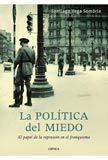New Spanish Books: The online guide of titles from Spanish publishers and literary agents with rights for translation in the UK. To consult titles available in other markets please click on the above links.
la politica del miedo
The Politics of Fear. The Role of Repression under Franco

Publisher:
Critica Language:
Spanish
Year of Publication:
2011
Pages:
432
ISBN:
978-84-9892-204-2
Genre:
Social Science and religion
Season:
AUTUMN 2011 SYNOPSIS
Repression is usually regarded as a consequence of the Civil War and the violence which the conflict aroused on both sides. But Santiago Vega Sombría now offers us a new and very different point of view.
He is not dealing here only with the deaths, the executions and assassinations used between 1936 and 1975 to paralyse the opposition with terror, but examining as a whole all the different ways in which a policy of fear aimed at securing submission was imposed: the prisons, confiscation of property, purges and other forms of coercion from beatings and castor oil to humiliation, including the methods reserved especially for women, and the symbolic violence practised in schools, churches and on the streets.
